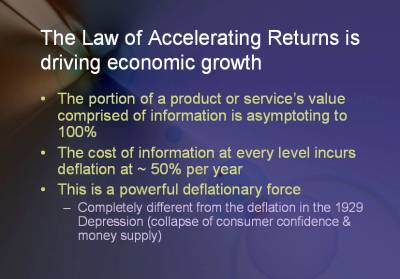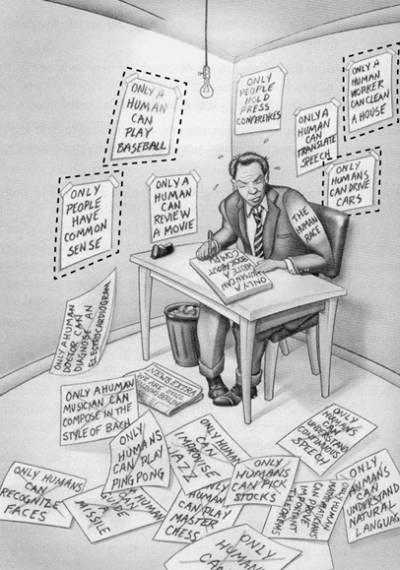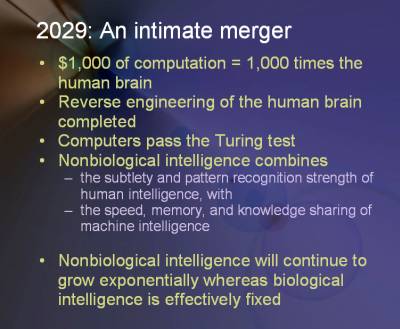How Neuronanotechnology Will Lead to Melding of Mind and Machine
Ray Kurzweil
Page 7 of 8
We essentially hallucinate the world, because we actually don’t see it. We only see these very low resolution movies, but we’re able to have the illusion that we see a high resolution image.
But these insights have enabled simulation of the visual system to perform with much greater performance because there’s a very clever coding system.
And to another point, modeling systems at the right level is very useful to simulate one neuron, which is vastly complex. And as we go up to higher levels, and look at the function of the whole region, like the cerebellum, or the hippocampus, those are not simple either.
But we find that they’re simpler than a single neuron, just as the pancreas is simpler than the pancreatic islet cell. You might say the pancreas is different because the pancreas is just a glob of cells whereas there’s intricate circuitry in the brain. Still the same principles apply. As we find out what these regions are doing to transform information, the models are not simple but they’re much simpler than the lower level description of the individual neurons.
All this is driving economic growth. I don’t want to dwell on this, but this is an interesting chart on e-commerce growing smoothly and exponentially, and it’s now a trillion dollars. You might say wait a second, wasn’t there a boom and a bust in e-commerce? How come we don’t see that anywhere here?
That turned out to be just a capital market phenomenon. Wall Street looked at the internet and said “wow, this is going to change everything. This is going to turn every business model on its head,” and all these valued soared, in 1999 and 2000.
And that is true. It is going to do that, and it’s going to do that exponentially, but exponentially isn’t instantly. So Wall Street came back a couple of years later and said, “it hasn’t changed every business model; I guess we were wrong,” and all the values went the other way.
Meanwhile, it has progressed exponentially. Three years ago people were saying you can’t make money in internet advertising. Now you’ve got one company with 99% of its revenues from internet advertising and it’s worth $100 billion.

Image 31
There’s been smooth exponential progression in this technology, and that boom/bust phenomena is an accurate harbinger of what ultimately is a true revolution.
We had ours in AI in the ‘80s. There was one in telecommunications, and Martine Rothblatt [1] with her exquisite timing built up a very successful telecommunications company. She got out at the boom then went into biotech, which again was very good timing. We had it with the railroads, this boom bust phenomena.
Let me show you one other example of self-organizing in our own technology. We took some of our speech recognition which we worked on for many years. We developed the first large vocabulary speech recognition system. There was also speech synthesis. We took contemporary versions of that and put them together with language translation. That’s an area that’s progressed a great deal: it’s not so narrow. It’s using pattern recognition. The early systems used rules, as it’s been pointed out, and now they’re using self organizing pattern recognition.
When I was at Google they showed me a system that can translate from English to Arabic and Arabic to English. They have these very large corpuses of translated text, Rosetta stone texts [2], and the system created its own rules. Nobody on the team spoke a word of Arabic, yet the system compared equally to human professional translators and won the DARPA competition.
I put together a translating telephone. I’ve used this to communicate with people who don’t speak English, and we were able to communicate just fine. Although people misunderstand each other even if they’re speaking the same language. This will be a routine service of your cell phone early in the next decade.

Image 32
I don’t want to dwell on this, but I will make a point about this picture, which was in The Age of Spiritual Machines in 1999 without the dotted lines. I put it in this book, The Singularity Is Near. This man, symbolizing the human race, is pointing out that computers can’t do something or other, and a lot of failed examples of that are on the floor, and there are still a few examples on the wall. I put dotted lines around the things I think will fall off the wall within the next decade.
I was at George Gilder’s [3] conference this fall, and Gilder chided me on the automobile driving example. He pointed out that they just had this competition where all the cars ran off the road very quickly. I said because exponential growth progress tends to zoom before the very end, in the next year or two I thought the cars will make that. Five weeks later, Sebastian Thrun’s [4] car and four other cars made this very difficult, 300 mile route, a circuitous route.

Image 33
In 2029, $1,000 of computation will be a thousand times more powerful than this figure, ten to the sixteenth, which I believe is sufficient for functional emulations. This is not simulating every neuron, but I don’t think that’s necessary. We’ll have completed the reverse engineering of the human brain in terms of the salient principles of operations. We’ll have simulations of all the different regions.
And I believe a computer will pass the Turing Test and I believe the progress will come from general AI and from reverse engineering the human brain working together. All of them are going to provide a handsome expansion of our AI tool kit.
That will necessarily be more powerful than human intelligence because it will combine the natural advantages of the machine with the powers of human pattern recognition. But it is not an alien invasion. I think an important issue with uploading is to understand that we’re going to merge with this technology. You’re not going to be able to walk into a room and say “humans on the left side of the room and machines on the right.”
Footnotes
1. Martine Rothblatt - Martine Aliana Rothblatt Ph.D, MBA, J.D. is a lawyer, author, and entrepreneur. Dr. Rothblatt graduated from UCLA with a combined law and MBA degree in 1981, then began work in Washington DC, first in the field of communication satellite law, and eventually in life sciences projects like the Human Genome Project.
http://en.wikipedia.org/wiki/Martine_Rothblatt November 14, 2007 4:45PM EST
2. The Rosetta stone text - The Rosetta Stone is a black basalt slab bearing an inscription dating from the year 196 BC. It was the crucial key to the deciphering of Egyptian hieroglyphs, and the foundation of modern Egyptology. The stone was discovered in 1799 by the French troops in Napoleon's military expedition.
http://www.egyptologyonline.com/rosetta_stone.htm November 14, 2007 4:48PM EST
3. George F. Gilder - (born November 29, 1939, in New York City) is an American writer, techno-utopian intellectual and co-founder of the Discovery Institute. His 1981 bestseller Wealth and Poverty advanced a practical and moral case for capitalism during the early months of the Reagan Administration.
http://en.wikipedia.org/wiki/George_Gilder November 14, 2007 4:50PM EST
4. Sebastian Thrun - (born 1967 in Solingen, Germany) is a Professor of Computer Science at Stanford University and director of the Stanford Artificial Intelligence Laboratory (SAIL). He led the development of the robotic vehicle Stanley, which won the DARPA Grand Challenge in 2005 and brought Stanford a two-million dollar prize.
http://en.wikipedia.org/wiki/Sebastian_Thrun November 14, 2007 5:04PM EST